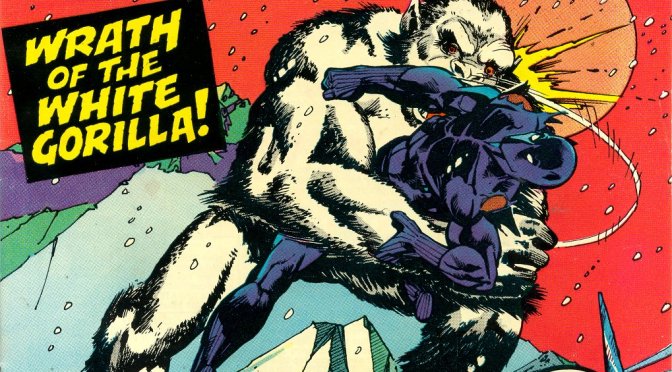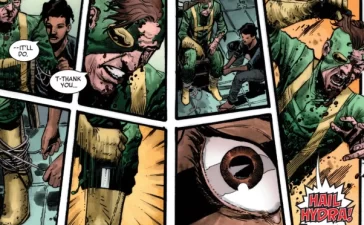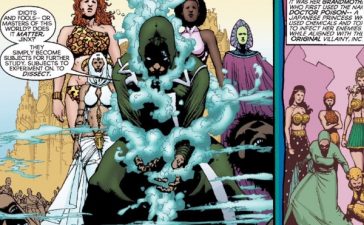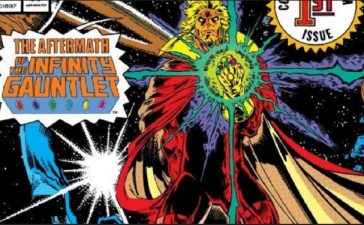On Friday at New York Comic Con, Marvel held a panel observing the 50th Anniversary of Black Panther. Created in 1966 by Stan Lee and Jack Kirby, Black Panther debuted in the pages of Fantastic Four #52. Lee and Kirby were at the height of their collaboration at this moment, having just wrapped a string of stories introducing iconic figures such as the Inhumans, Galactus and Silver Surfer. The issue prior (#51) told the classic tale “This Man . . . This Monster!” Given this high level of quality, it is hardly surprising that they would not miss a beat when premiering The Big Two’s first black superhero. Two years later, Roy Thomas added the Panther to the ranks of The Avengers just in time for T’Challa to share Earth’s Mightiest Heroes’ initial encounters with Ultron and The Vision.
Despite their canonical status, the NYCC panel was mostly silent on these earliest Black Panther stories. Instead, they cited the work of writer Don McGregor as the foundational Black Panther tales. In the early 70s, Marvel launched Jungle Action as a low-profile series reprinting old adventure stories from the 1950s. However, much had changed in America since the 50s and McGregor found much of these stories racially offensive. (A cursory glance at the initial covers suggests that these narratives revolved around a generic Tarzan type rescuing a fearful white woman from all sorts of rampaging jungle beasts). Eventually editorial grew tired of McGregor’s complaining and assigned him the task of writing new scripts for the series. As McGregor explained, “jungle books didn’t sell, so what did they have to lose? They could simply cancel the series and say ‘hey we tried.’” Then in the tradition of Frank Miller, Jim Starlin and other creators reviving moribund properties, McGregor refashioned Jungle Action into something iconic.
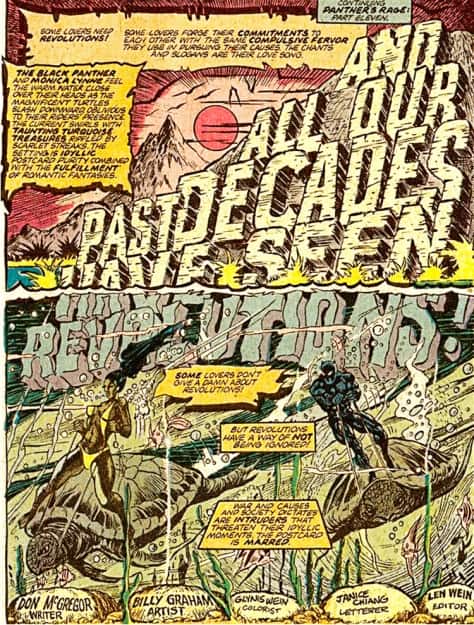 Billy Graham
Billy GrahamA common refrain through the panel was how important the setting of Jungle Action was. While Lee and Kirby’s original Black Panther narrative was set in Wakanda, Thomas relocated the hero to New York. McGregor believed it was important to set the stories within the boundaries of Wakanda. As a result, his entire cast consisted of Africans. This allowed for McGregor to present African life through a wide range of human experience. All types from hero to villain to the everyday citizen in-between were African. Despite the freedom of scripting a second-tier book, McGregor’s conception would occasionally run into resistance from editorial. Concerns about cultural perception initially prevented black villains from being featured on the covers. McGregor related how he was constantly being badgered to put more white people, such as the Avengers, in the book. Then when he pitted T’Challa against the KKK, editorial grew nervous. McGregor’s simply responded “but you wanted me to put white people in the book.” To Marvel’s credit, they let him tell his story about the Klan.
The theme of representation echoed throughout the panel. Actor James Monroe Inglehart spoke of how comics such as Black Panther offer escapism from the troubles of contemporary society. At the same time, though, they present an alternative message to despair. A child learns strength from Black Panther. They read his adventures, watch him in the movies, then sees his Halloween costume. The child learns that they too can be T’Challa, they can live his example. Current Panther writer Ta-Nehisi Coates related how when he was young, comics were one of the more progressive mediums in terms of black characters. His first Iron Man was not Tony Stark, but James Rhodes. When Coates began reading X-Men the team was led by an African woman. He remains struck by the emotional depth of writer Chris Claremont’s treatment of powerless Storm. Here were black heroes and heroines depicted with a degree of complexity lacking from mainstream movies and television of the period. Former Panther scribe Christopher Priest agreed that the nation of Wakanda offered an example of hope, which stood in stark contrast to the all too real troubles of the continent. Alitha Martinez, part artist of Black Panther and future artist for the upcoming World of Wakanda series, spoke of the tradition of strong female characters having a prominent place within T’Challa’s circle.
For Priest, comics are about selling relationships. Fans aren’t just searching for more than cool costumes or exciting adventures; they want a protagonist to whom they can relate. On this score, Priest sees much work left to be done, especially behind the scenes. He stated the view that there is a direct correlation between lack or minority talent and lack of minority characters. In addition to a more diverse creative pool, Priest expressed concern about the recent trend of minority legacy/replacement characters. Instead of making Falcon the new Captain America, publishers such as Marvel should concentrate on crafting original minority characters such as Sam Wilson, Luke Cage and, of course, T’Challa were back when they first debuted.
Thus, the current creators continue to refine T’Challa’s world, building on McGregor’s narratives, in order to make Wakanda an even richer setting. Artist Brian Stelfreeze related how he was thinking about graduation of skin tones for Black Panther. He decided to give T’Challa and his relatives the darkest skin, thus, communicating that the darker coloring was synonymous with the status of the royal family. Initially he was worried Marvel would object, only to find Editor in Chief Axel Alonso wholeheartedly signed off on the idea.
Prompted by an audience question, Coates discussed how he developed the concept for making Aneka and Ayo lesbians. Coates observed that in the aftermath of previous storylines, most of the male figures from T’Challa’s orbit were dead. As a result, Coates’ thoughts turned to the surviving female figures, especially the royal guard, Dora Milaje. Here is an organization pledged with preserving the life of the king, yet also a tightly bound all female environment. What kind of tension does that create between the needs of the state and the needs of the individual? What are the personal wishes of each Dora Milaje? Such questions naturally led Coates to the subject of lesbianism, which he was initially hesitant of portraying explicitly. However, once he saw Stelfreeze’s art, he knew he could trust the artist with avoiding the pitfalls of a leering male gaze.
As an aside, McGregor volunteered that he originally intended for two characters in his Jungle Action run to be homosexual, yet, knew that was a non-starter for Marvel. It would be another twelve years before McGregor had the freedom of writing a pair of clearly homosexual characters for his title Detective Inc., and even then he needed to turn to the independent publisher Eclipse.
Stelfreeze also spoke of cultural changes. He related how despite being a published comics artist since 1988, it was only in the last eight years he was known as a “black artist.” In the past, he would meet editors at conventions who would be surprised to learn that he was black. Today, the internet makes information about cultural identity immediately available by means of a simple Google search. While this does present a danger of pigeon-holing creators, it also offers positive opportunities. Readers can see not only heroes who resemble them, but creators as well. Not only can a teenager learn the strength of the Panther, they can also be inspired to create his next adventures for another generation. Stelfreeze mused that he wishes he could compose a letter to his sixteen year old self, excitedly conveying the adolescent’s future success. As Stelfreeze observed, “I have to come up with new dreams, since I keep fulfilling the old ones.”
Despite all the ills which continue to plague our society, the nation of Wakanda may still offer us hope for something better.
Cheers.





